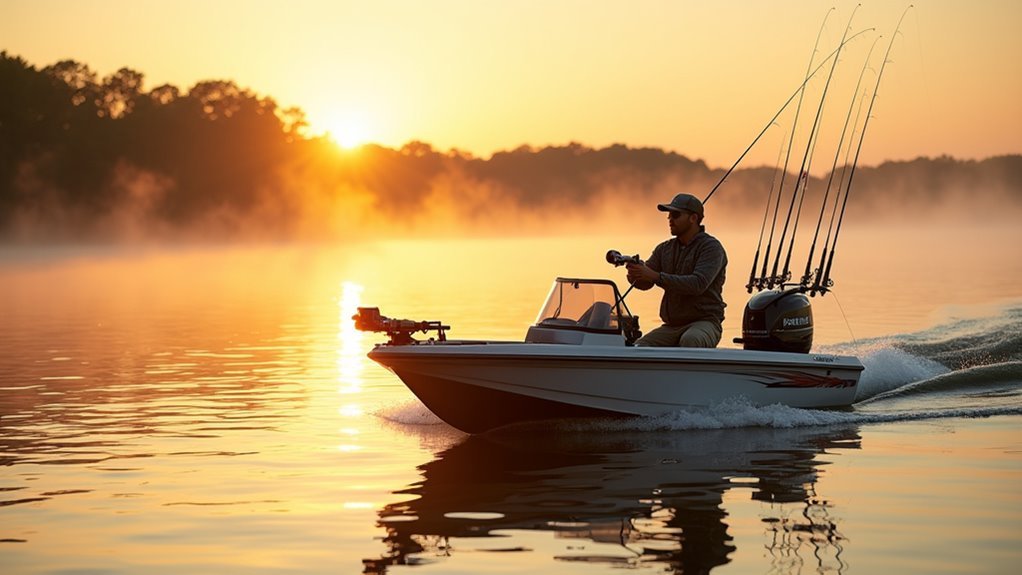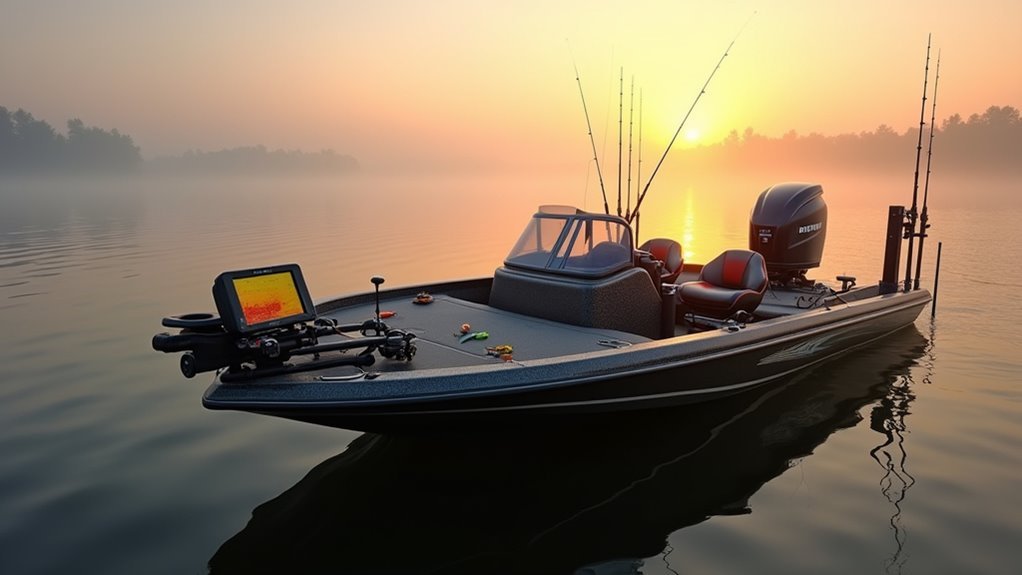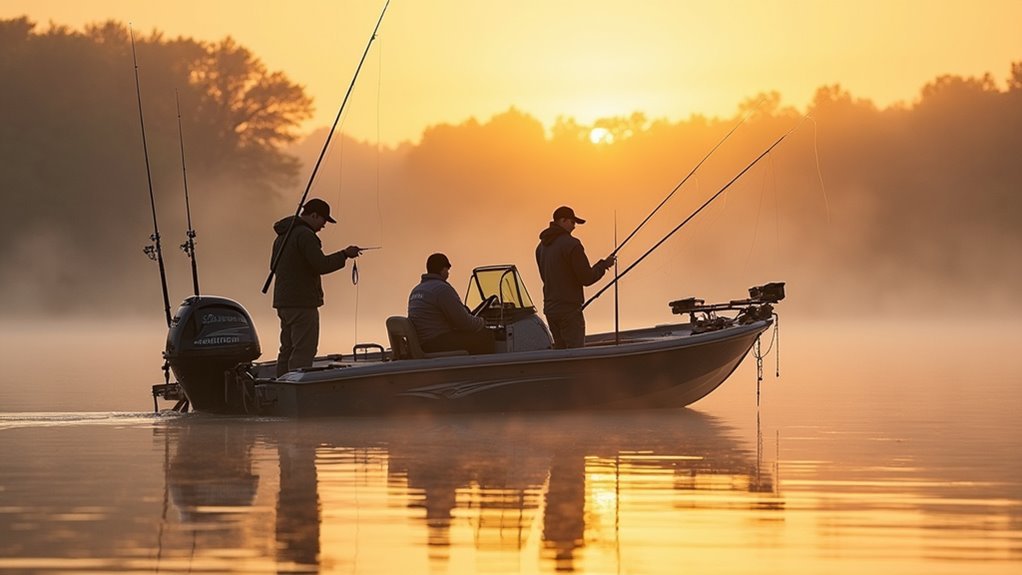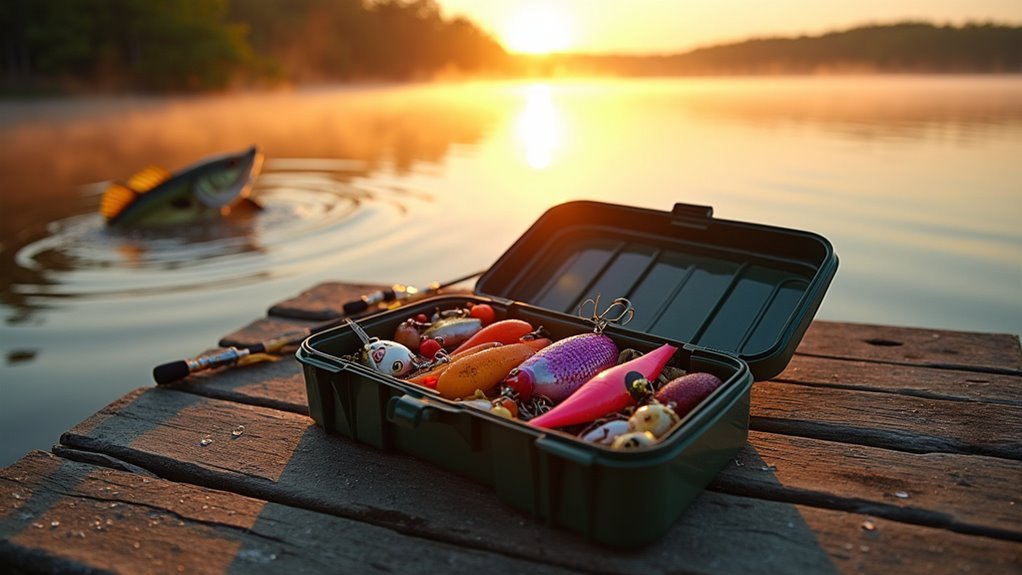We’ve found trolling for bass combines science with strategy. By matching your lures to local forage and adjusting your speed (around 1.5 mph is a good starting point), you’ll trigger those predatory instincts. Use medium-heavy rods with quality reels, and don’t forget to adapt to seasons—shallower in spring, deeper in summer. Water clarity matters too; clear water means deeper presentations, while murky conditions bring fish up. Our favorite technique will transform your next fishing trip completely.
The Science Behind Trolling for Bass

While many anglers think of trolling as simply dragging lures behind a boat, there’s actually fascinating science behind why it works so well for bass fishing. The motion of your boat creates a perfect presentation that mimics natural prey movement in the water. Bass, being predators, are triggered by this consistent action.
We’ve found that water depth and clarity play essential roles too. In clear water, bass tend to strike deeper, while in murky conditions, they’ll hit closer to the surface. The vibration, flash, and sound your lure produces while trolling creates a sensory experience that bass simply can’t resist. It’s like ringing the dinner bell! Additionally, understanding hydrodynamic forces helps in optimizing your trolling techniques for better results.
Essential Gear and Setup for Bass Trolling Success

Before you can experience the thrill of a monster bass striking your trolled lure, you’ll need to equip yourself with the right gear. We’ve learned through years on the water that a medium-heavy rod with a flexible tip works best for detecting those subtle strikes. Pair it with a quality trolling reel that can handle 15-25 pound line.
Don’t skimp on line quality – we once lost a trophy bass when our cheap line snapped mid-fight! A reliable fish finder is essential for locating underwater structures where bass hide. And finally, stock your tackle box with crankbaits and swimbaits in colors matching your local forage. Additionally, consider using a trolling motor with GPS integration to enhance your fishing efficiency and ensure you stay on top of the best fishing spots.
Seasonal Strategies: Adapting Your Trolling Approach

As seasons shift throughout the year, successful bass trolling demands strategic adjustments to match changing fish behavior. We’ve found that spring calls for slower trolling speeds around spawning areas, using brighter lures in shallower waters where bass are more active. Summer heat pushes bass deeper—that’s when we target 15-25 foot depths with crankbaits. I once landed a 6-pounder off a deep ledge in August when nothing else was working! Fall requires following baitfish migrations, while winter demands the slowest retrieves near deeper structure. Remember, water temperature dictates bass location more than any calendar date. Additionally, understanding battery types can significantly enhance your trolling motor efficiency for longer fishing trips.
Speed and Depth Control: The Critical Variables

When trolling for bass, nothing influences your success more than mastering speed and depth control—truly the heartbeat of effective trolling tactics.
We’ve learned through countless trips that bass respond differently to varying speeds. Too fast and you’ll scare them; too slow and they lose interest. We typically start around 1.5 mph, adjusting based on the lure and conditions.
Depth control requires understanding both your target zone and how your lure behaves. We use planers and downriggers to hit multiple depths simultaneously. Remember, clear water pushes bass deeper, while murky conditions bring them shallow. Additionally, using the correct thrust requirements for your boat ensures you maintain control and responsiveness while trolling.
Trust your fish finder—it’s your underwater eyes!
Top-Performing Lures and Rigs for Trophy Bass

Once you’ve dialed in your speed and depth, selecting the right lures becomes your next mission for hauling in those trophy bass. We’ve found that crankbaits are absolute dynamite for trolling because they create their own action. We once pulled in three 5-pounders in an hour using deep-diving models near a drop-off!
Swimbaits and spinnerbaits also deserve spots in your tackle box. Match colors to water clarity – bright on cloudy days, natural tones in clear water.
For striped bass, try the Tube and Worm Rig in warm water or a Bunker Spoon with 50-pound line. These setups have turned many quiet days into stories we still tell. Additionally, remember that shaft length selection can significantly impact your trolling efficiency and success on the water.
Expert Techniques for Targeting Different Bass Species
How do you maximize your success when targeting different bass species? We’ve found that largemouth, smallmouth, and striped bass each require distinct approaches. For largemouth, we typically troll crankbaits along weed lines at 1.5-2 mph. Smallmouth prefer faster presentations—try swimbaits at 2-3 mph near rocky drop-offs.
Striped bass are our deep-water specialists. We’ve had incredible luck with umbrella rigs in deeper channels. Last summer, we boated a 28-pounder using a bunker spoon at 25 feet!
Frequently Asked Questions
How Do Electronics and Mapping Integrate With Trolling Techniques?
We use fish finders to locate bass, map underwater structures, and mark successful spots. Our electronics help us track depths, monitor speed, and navigate to prime trolling locations efficiently.
Can Trolling for Bass Work Effectively in Extremely Shallow Waters?
We don’t recommend trolling in extremely shallow waters. It’s ineffective because your lures will snag on bottom structures, and the boat’s presence may spook bass in clear, shallow environments.
How Do You Handle Multiple Hookups When Trolling With Several Rods?
Nearly 65% of multi-hookup situations lead to lost fish. We’ll handle simultaneous strikes by designating rod responsibilities, calling out “Fish on!”, reducing throttle immediately, and clearing other lines methodically to avoid tangles.
Does Trolling Negatively Impact Catch-And-Release Bass Survival Rates?
We haven’t observed significant negative impacts on bass survival when trolling properly. However, we recommend using circle hooks, minimizing fight time, and handling fish gently to maximize catch-and-release success.
What Modifications Help Trolling Tactics Work During Major Weather Fronts?
During cold fronts, we’ve found slowing our trolling speed, using brighter colors, and trolling deeper waters helps. We also recommend adding rattles to lures and switching to smaller presentations.
Conclusion
Just as we were about to give up last summer at Lake Powell, we switched to trolling and landed three trophy bass in an hour! We’ve shared our best techniques with you, and now it’s your turn. Remember, trolling isn’t just about dragging lures—it’s about precision, patience, and presentation. We’re confident you’ll soon be creating your own success stories on the water. Tight lines!